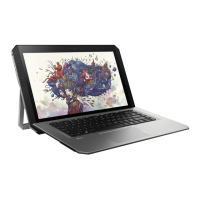Items Procedures
6. Test with a veried working operating system hard drive, if available.
Note If there is a hard drive POST error message, see POST Error Messages and User
Actions on page 123.
Read-write error
Items Procedures
Symptoms
● Post error message (i.e., error code 301)
● Hang when working on data, les, documents
Possible causes
Loose connection, faulty hardware.
Troubleshooting steps
1. Perform a hard reset (8. Hard reset on page 70).
2. Reset BIOS to default (9. Soft reset (Default Settings) on page 71).
3. Verify drive connection and ex cable. Reseat connection (10. Reseat cables
and connections on page 72).
4. Use the HP Hardware Diagnostics tool to test. If failed, record failure code and
have the hard drive replaced.
5. If no error with HP PC Hardware Diagnostics (UEFI) tool, try to repair the hard
drive and its les in Windows (using command “CHKDSK /f /r /x”). Use
HP Restore to reinstall the operating system, if needed.
6. Test with a veried working hard drive. If it is not recognized, the system
board is faulty.
Note If there is a hard drive POST error message, see POST Error Messages and User
Actions on page 123.
Slow performance
Items Procedures
Symptoms
Slow performance even when performing small
read/write operations
Possible causes
Operating system les, hard drive is full.
Troubleshooting steps
1. Transfer data from the hard drive to create more space. Microsoft
recommends at least 200 MB to sync system les.
2. Perform disk defragmentation to consolidate fragmented data on the hard
drive so it will work more eciently.
NOTE: Do not defrag an SSD.
Tips & tricks For optimal system performance, you need to place your operating system and all
of your most commonly used applications and les in the fastest hard drive (solid-
state drive) and fastest areas on the drive (primary partition of 200 GB max).
See Routine Maintenance for Performance Improvement on page 125).
Common issues and possible solutions 113

